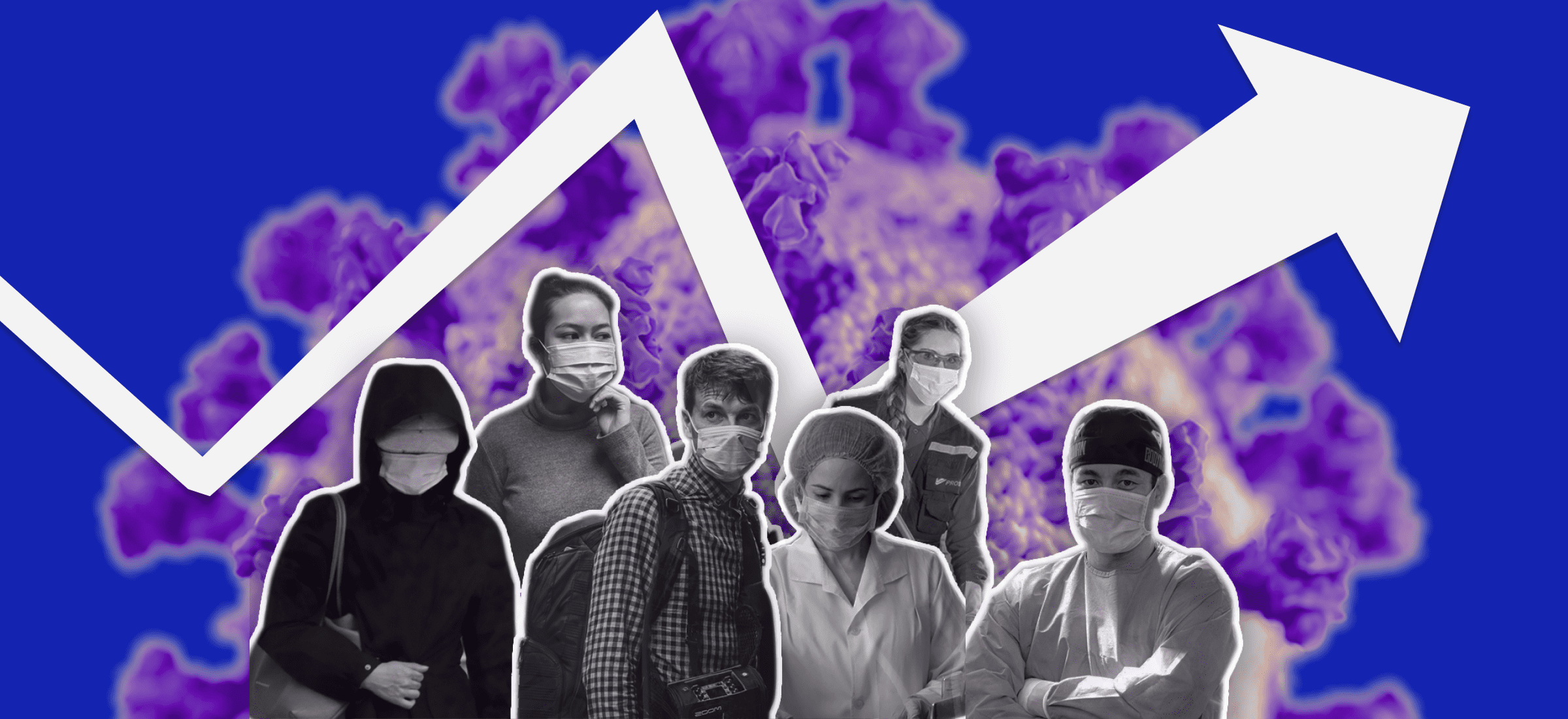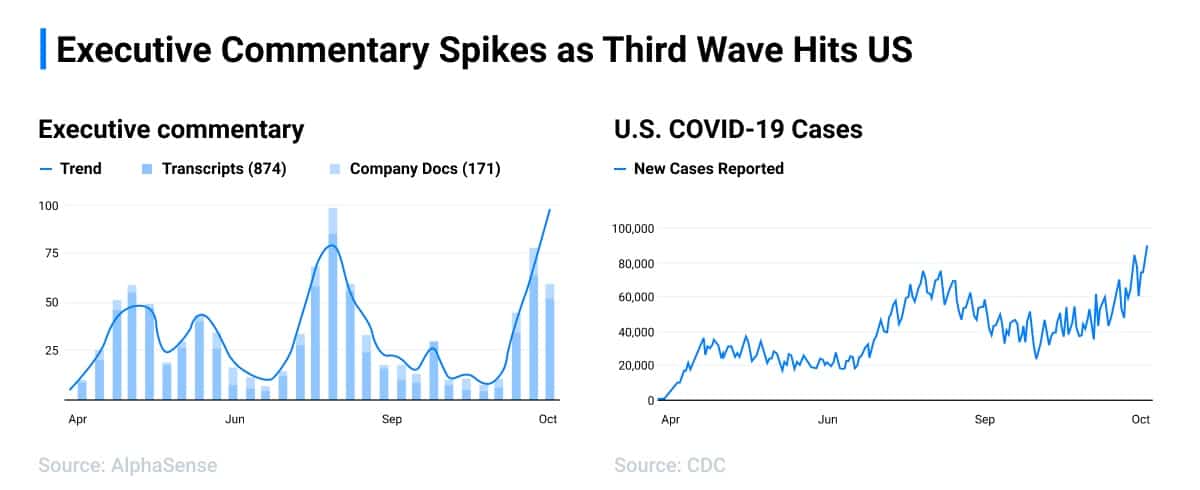This week, the United States surpassed 9 million COVID-19 cases, with a single-day record of 80,622 infections. These rapidly rising case numbers, particularly through the West and the Midwest, have positioned the United States for another overwhelming (and more widespread) surge. Hospitals throughout the country are again reporting shortages of basic equipment and drugs to treat COVID-19.
Meanwhile, hard-hit companies are beginning to rally. During Q3 earnings calls, executives noted that, despite rough waters, they had noticed increased spending and engagement with their brands. These corporate leaders commented on how a second wave (now third wave) will impact their businesses, noting that, despite uncertainty, they predict that they will be hit much less hard than during the first wave of COVID, mostly thanks to new protocols and restrictions.
All of this occurred as the Stock Market took a huge plunge on Wednesday due to a spike in COVID-19 cases, dropping 942 points as the S&P turned negative for November. Below, we’ve compiled executive commentary from earnings calls on the second- and third-wave of COVID cases.
To track executive commentary about the impact of increasing COVID-19 case count, unlock free trial access to AlphaSense or login to your account.
Featured Comments:
- Starbucks CFO: “We found that the operational disruption of this second wave, so to speak, is less severe than the initial wave in terms of the depth of impact and its duration.”
- Apple CEO: “Everybody, to the best of their ability, is putting in contingency plans and finding a way to adapt to the environment. But it is difficult to call, and there’s a level of uncertainty in it, obviously.”
- Royal Caribbean CEO: “After 7 months of agony, the prospect of a further surge is beyond frustrating.”
Honeywell (Earnings Call Transcript – October 30, 2020)
Gregory Lewis – CFO: Our current planning expense is that COVID-19 vaccine receives approval and becomes available sometime in early 2021, allowing the global economy to largely reopen as the year progresses. We’re also assuming fiscal stimulus remains supportive of the economy. We’re currently seeing a second wave of infections in several regions, including the U.S. and parts of Europe, so we’ll need to watch how that situation develops. We’re assuming no significant shocks to the economy from postelection circumstances and a stable geopolitical environment, particularly as it relates to U.S.-China trade relations.
SunCor Energy Inc (Earnings Call Transcript – October 29, 2020)
Answer – Mark S. Little: Yes, Neil. Great question. I mean nobody really knows. The second wave of COVID is a bit of a challenge. I think the relative performance of us relative to the market, we’re extremely confident in because of the physical integration you talk about. The good thing about it is we’re seeing right now in the markets gasoline’s off something like 5% in North America, probably 5% to 10% on the distillate side, jet’s off 50%.
So could this soften if we get a big wave and everybody shuts everything down? I think it could. Do I see it going back to where we were in the second quarter? I don’t because lots of governments are working very hard to keep their economies going. I think it’s far more apparent now that we’re really balancing 3 challenges: The COVID physical health issues; the mental health issues; and then the economic issues, and the economic issues are very significant, as you know.
Starbucks (Earnings Call Transcript – October 29, 2020)
Answer – Kevin R. Johnson: … What I believe to be true is we have developed these store protocols that now have been embedded in the operation processes for how we run our Starbucks stores around the world. And those store protocols have — they are enabling us to operate in the world of COVID. And so even in the world of COVID where in certain markets it’s — the curve is increasing, in other markets the curve is flattening, we’ve been able to see sequential improvements in same-store comparables.
Answer – Patrick J. Grismer: I think Kevin said it really well in terms of the level of resilience that we’ve built into our business, which gives us the ability to manage much more effectively going forward. And we have seen examples already just in the last couple of quarters, whether in Beijing and Dalian in China or as well as in states like California, Texas and Florida in the U.S., where in each case, we’ve been able to work with local authorities, adjust our store operations as needed. And we found that the operational disruption of this second wave, so to speak, is less severe than the initial wave in terms of the depth of impact and its duration.
Apple (Earnings Call Transcript – October 29, 2020)
Answer – Timothy D. Cook: Well, we’re doing everything we can do, but we’re prioritizing safety first, obviously. And so with our stores as an example, we’ve come up with a new concept that puts an — essentially turns the store into an express storefront. And we’ve implemented that in a number of places where we believe it helps from the safety of our employee and the safety of the customer’s point of view but still allows for an interaction to take place.
And so we’ve also put a lot more people on the phones because a lot more people are reaching out to us in that way. And of course, the online store has stayed up and running through the whole of this. I think if you take some of those, the channel is doing some similar things and then some different things as well. And so I think everybody, to the best of their ability, is putting in contingency plans and finding a way to adapt to the environment. But it is difficult to call, and there’s a level of uncertainty in it, obviously, and that’s what Luca was referring to earlier.
Charles River Laboratories International (Earnings Call Transcript – October 29, 2020)
I mean I thought right now, and of course, we’re in the midst of the second wave, the second wave, and the first wave and a new second wave for sure, you still think we’re going to exit the year pretty much at a historical run rate for research models, both products and services.
So China will be strong in services. We’ll be strong in the U.S. and Europe, which would be (inaudible) by COVID will not be. And we think it’s highly unlikely that there will be a major sort of, I mean, unless there’s a major shutdown across these sites, which we can’t imagine what the rationale would be given the learning curve that we all have and all these institutions have had.
Wex (Earnings Call Transcript – October 29, 2020)
If we go into something where you see more of a shutdown to say, right now, what we’re seeing across the business is even in regions where they’re starting to have more COVID activity, we’re not seeing big, huge swings and customer behavior like we did in the second quarter, so far, knowing that there’s a lot of unknown out there. But what we’re seeing really is this almost like parts of the world are operating — they’re operating so that essential businesses are continuing to happen. And in — a little bit more than that, but it’s already this muted level of activity that’s happening.
And so as a vaccine comes out, we do expect that you’re going to see that behavior pattern change, go back to the way it was before. But as COVID activity increases, we’re already operating off a base where the activity has been more muted, so we’re not seeing as much of a trend down.
Royal Caribbean Cruises (Earnings Call Transcript – October 29, 2020)
One of the most frustrating elements of COVID-19 is how little the world knew at the beginning of this pandemic about the virus and how many false paths we have all gone down over this period. Fortunately, the sciences made remarkable strides, and there are a few observations and predictions that we can make.
We are seeing an upsurge in infections in the United States and in other countries around the world. The experts seem to expect a second wave over the coming months. After 7 months of agony, the prospect of a further surge is beyond frustrating.
However, the advances on the science fronts give us optimism that this coming surge will not be as devastating as the early surges in March and April, and it will lead to a better 2021. Therapies are dramatically better and they are more effective. Testing capabilities are already at extraordinary levels and moving higher. And the progress on vaccines has advanced at unprecedented speeds.
Spotify (Earnings Call Transcript – October 28, 2020)
Answer – Paul Aaron Vogel: Yes. As I said earlier, we don’t give specific guidance on Premium versus ad, but I did say we expect that the year-over-year growth in advertising in Q4 will be higher than what we saw in Q3. Obviously, there’s a lot of uncertainty around COVID around a second or third wave. And so there’s some conservatism in our numbers. We would hope, but again, there’s a lot of uncertainty as well.
Yandex (Earnings Call Transcript – October 28, 2020)
All in all, Q3 was indeed a good quarter for us. However, the second wave of COVID is already emerging, and the number of new daily cases is above May’s peak level. The situation remains uncertain, and until there is a greater clarity, we will maintain our conservative approach to cost, hiring and capital allocation. We believe we are now better prepared to face the challenges compared to 6 months ago because: first, we have learned to use our resources even more efficiently and continue to improve our unit economics even in the toughest times; and second, we have seen a number of new exciting opportunities, which we believe will add to our long-term growth potential.
Sony (Earnings Call Transcript – October 28, 2020)
COVID-19, was quite significant in terms of revenue and earnings. But this will be alleviated. The adverse impact will be alleviated. Of course, there will be regional differences. There could be the second and third wave in certain geographical areas. But I think we know better how to adapt to such environment. We believe that we can better accommodate the new environment. So overall, there will be an improvement.
Johnson & Johnson (Earnings Call Transcript – October 13, 2020)
Answer – Jennifer L. Taubert: We think that our customers as well are really adapting and figuring out how to use a combination of both telehealth as well as in-person visits depending upon the actual patient and potential diagnosis. And we see very positive trends going forward. And should there be any type of second wave, we think that they’re going to be much better able to handle that in the second wave than what we saw originally.




